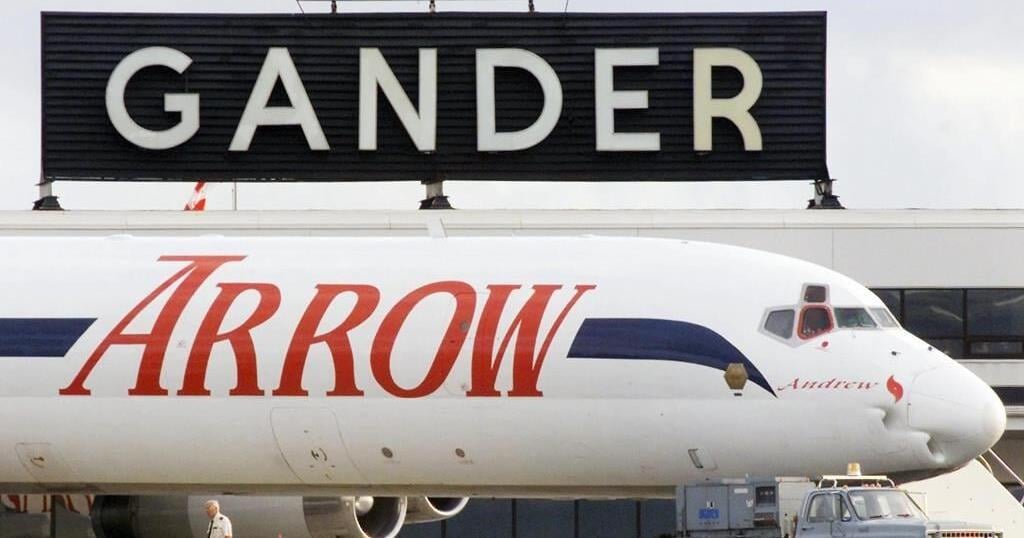MONTREAL – From his office overlooking the runway at Gander International Airport, Reg Wright can see all flights in and out of his corner of Newfoundland.
But in recent years, those plane spottings have been fewer and farther between.
“In Newfoundland, we have a saying called the fisherman’s widow, which is typically anyone that keeps eyes to the sea to see that their husband will return. During the pandemic, I did spend a lot of time in the posture of looking out the window, counting numbers and wondering when recovery was coming,” Wright said.
He’s still counting.
The airport has lost four routes since 2019, including a WestJet route to Halifax, he said. “A third of our passengers have vanished into thin air …. By no means are we recovered.”
Gander serves as a microcosm for numerous towns and cities across the country. While Canada’s total domestic passenger numbers now hover at around pre-COVID levels, air travel to smaller communities and even medium-sized cities has withered, pushing up fares and leaving parts of the country less connected.
The 30 biggest airports in Canada have seen passenger capacity return to 98 per cent of 2019 levels on average,according to the Canadian Airports Council. The next 30 are at barely 70 per cent.
Driving the travel rebound is a surge along big-city routes. Flight volumes rose 19 per cent for Vancouver-Montreal, 12 per cent for Toronto-Vancouver, 10 per cent for Calgary-Vancouver and a whopping 51 per cent for Ottawa-Calgary over the past five years, according to figures provided to The Canadian Press by aviation data firm Cirium.
Correspondingly, airfares fell between two and 11 per cent on those routes despite rampant inflation and widespread fare increases.
However, regional air travel still sits far below 2019 levels.
A random sampling tells the tale. The number of direct flights plunged 49 per cent for Sault Ste. Marie-Toronto, 41 per cent for Regina-Calgary and 100 per cent for Quebec City-Rouyn-Noranda between May 2019 and May 2024. Driving between those cities would take at least five to seven hours, with zero stops.
Meanwhile, fares on flights linking those city pairs rose 54 per cent, 16 per cent and 173 per cent, respectively, according to Cirium.
Airports in far-flung communities serve as key hubs for critical services.
“If you’re in the Yukon and you need to travel to Vancouver for your medical appointments, these are the essential roles … whether it’s fighting fires, moving health-care workers, even getting food on our grocery store shelves,” said airports council president Monette Pasher.
A lack of timely air access also puts communities at an economic disadvantage.
“Aviation is really a load-bearing wall holding our country together. And there’s a lot of rural and remote communities like my own that are wholly dependent on air travel to have that economic and social utility and be meaningful participants in the global village,” said Wright.
“The stakes are very high.”
Fewer flights can complicate leisure and business travel as well, extending total travel times and sometimes result in exhausting layovers.
The dearth of departures has prompted some travellers to look south for flights — out of Detroit, Plattsburgh, N.Y., and Bellingham, Wash., for example — draining revenues from Canadian airlines and airports.
Several reasons account for the drop in regional flights.
During the pandemic, carriers took the opportunity to streamline their fleet by ditching older planes in favour of newer, bigger ones. The fresher aircraft are more efficient, as are business models that operate fewer flights and carry more passengers over longer distances. More customers per trip mean wider profit margins, while fewer takeoffs mean lower fuel costs, since airplane ascents guzzle up so much fuel.
A shortage of pilots, particularly on regional carriers, and a rise in salaries also help explain the dearth of service following a drop in enrollment at flight schools during the COVID-19 pandemic.
“You don’t get (pilots) out of a vending machine. It takes time,” Wright said.
“When pilot costs get to an inflection point like they have over the last three years, amortizing a pilot salary over 17 seats becomes virtually impossible,” added Duncan Dee, former chief operating officer at Air Canada.
Competition on many routes has declined too. WestJet withdrew from virtually all short-haul markets east of Winnipeg during the pandemic. Air Canada mirrored this move, remaining in Central and Eastern Canada while scaling back in the West.
In Cape Breton, residents now have to go through Montreal or Toronto if they want to fly to Halifax after both airlines cut back from a combined 240 flights per month to zero.
“For the first time in 75 years, we lost all our daily service,” Pasher said of the airport in Sydney, N.S., who lives in the area.
She and others have demanded a funding boost from the federal Airports Capital Assistance Program. It funds upgrades for small airports, but its $38-million limit has remained unchanged since 2000. Airports are calling for $95 million annually.
Other experts say more direct support for regional flights is needed, pointing south of the border. The U.S. Essential Air Service program ensures scheduled flights to hundreds of small communities by subsidizing air service that would otherwise not be profitable enough for carriers, which bid on the contracts.
“We’ve let the marketplace judge the viability of regional services,” said John Gradek, who teaches aviation management at McGill University.
Back in Gander, where residents’ hardiness and hospitality became known to the world via the Broadway hit Come From Away — the play chronicled their experience hosting more than 6,500 travellers from 38 planes that unloaded at the airport on 9/11 — Wright takes stock.
“Big throngs of people at Pearson or Trudeau doesn’t tell the story that, from coast to coast, there’s rural markets that are really on the brink in terms of air service.”
This report by The Canadian Press was first published Aug. 11, 2024.
Companies in this story: (TSX:AC)
